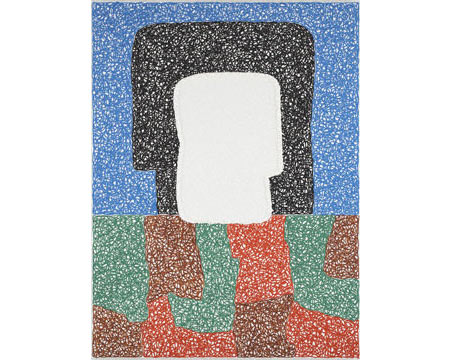
A post-modern/hybrid aesthetic remains technically sound, emotionally vibrant and as dependable as ever in the paintings of Jonathan Lasker. It has been fifteen years since Lasker first exhibited here, and thirty or so since, after studying at Cal Arts, his decisively abstract work pushed back at the notion that type of painting no longer was compelling.
Indeed, Lasker’s well considered canvases, delivered with characteristic sophistication and playfulness, account for themselves beautifully in this show. For example, in “The Inability to Sublimate,” a field of bold, black freely wandering doodles creates geometric apertures, whose round panels resemble the lead came of stained glass windows. The pattern works pervasively across these poetic yet structural curlicues, walling off the canvas’s negative space into a flowing field of reclining phantoms.
If gestural doodling represents art’s most unconscious act of mark making, then grid building stands as perhaps its most calculated one, and to reconcile both actions in one painting is an achievement. Indeed, in “The Inability to Sublimate,” two primary colored, broadly stroked and heavily impastoed grids positioned on either side of the canvas anchor the lines’ somewhat austere and airy wanderings with a more cleanly applied version of Abstract Expressionist gravitas. Furthermore, the dialog that unfolds here integrates the idea of the painter as art’s high priest with that of the grafittist as its outsider counterpart.
Lasker addresses (and in so doing transcends) the anxiety of influence in another beautiful piece titled “A Portrait of the Artist’s Father.” This cosmic, dreamy, laced and speckled canvas points to painterly forebears that might include Rufino Tamayo, Paul Klee, Dubuffet, and Milton Avery. The painting’s crystal-studded lines create blue, black, red, green and brown fields that swirl around the central image of a white silhouetted face, which both identifies the painting as a portrait and stirs up memories of winter’s freshness. The work also functions as a visual pun echoing Danish philosopher Soren Kierkegaard’s proclamation that “He who doesn’t work doesn’t eat, but he who works gives birth to his own father.”
In “Hidden Identity,” Lasker suggests that the act of viewing art functions as a metaphor for a kind of metaphysical puzzle solving. In this painting the artist composes another body of systematically stroked black lines, this time parallel to one another and positioned in obliquely angled groups. A rough weaving of boldly painted blue, red and yellow planks and a small, roughly cone shaped blob of pink paint sprout from the bottom of the image. A doodle suggesting curly black hair and another grid form of unbalanced cross-hatched lines extend and totter from the painting’s top, the latter pair of images suggesting both the painting’s entrance portal and its gatekeeper. Yet far from threatening, this friendly maze-like topography invites the gaze gently into its space, as if one were calmly looking out of a window. It says that only by redirecting the psyche’s energy inward can viewers begin to clarify and discover not this painting’s identity but their own.
Published courtesy of ArtScene ©2010
